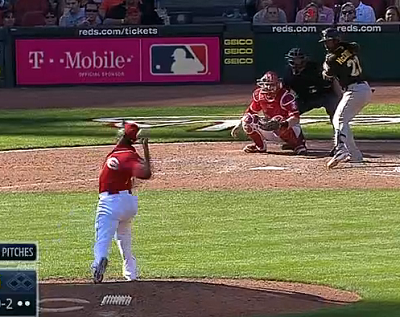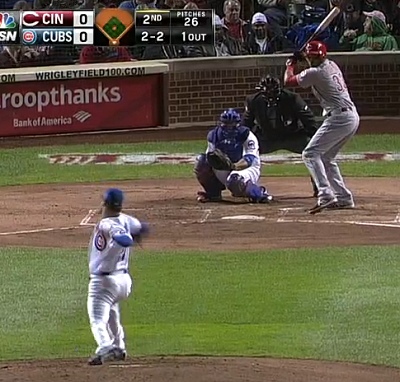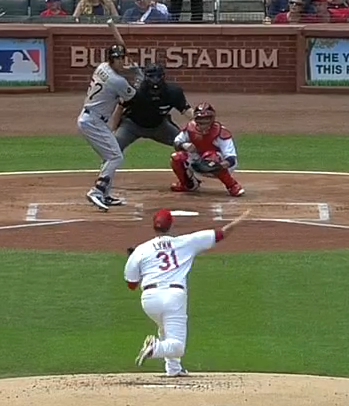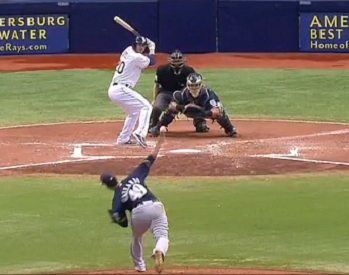With half of the league's divisions now in the books, we turn to the Best and Worst Mechanics of the National League Central. The division contains some of the greatest extremes in the game, from the largest torque to the worst posture, and yet the division falls a bit short on the overall scale, as the absence of an A-grade delivery sets the NL Central apart from the other divisions that have been covered thus far.
Balance
Best: Jeanmar Gomez, 70 grade
Gomez has a delivery that is extremely slow yet very stable, with some of the lowest momentum in the division yet the top balance in the NL Central. His stability manifests in all three planes, maintaining a head position that remains over the center-of-mass with little to no lateral movement throughout the delivery. He avoids the back-side collapse that has become so common, solidifying his vertical balance such that his head height follows a trajectory that is consistent with the slope of the mound. He avoids drifting too far out in front later in the motion, keeping his Z-plane balance in line from first movement through release.
Worst: Pat Neshek. 30 grade
A big part of Neshek's poor balance grade is tied to his submarine approach, bending forward at the waist during the stride phase of his delivery, and the fact that he throws constantly from the stretch effectively isolates the imbalanced stride as an outstanding portion of the delivery. True to sidewinder form, Neshek pops upright with plus posture by the time that he reaches release point, but his head is otherwise never above his center-of-mass in the time between first forward movement and foot strike. He can repeat the imbalanced motion relatively well, but his submarine technique guides his extreme lack of balance as well as his ultra-low release point.
Momentum
Best: Trevor Rosenthal, 70 grade
Rosenthal epitomizes a power delivery, with elite grades for both momentum and torque that both contribute to his high-90s velocity. His momentum is plus throughout the motion, including an excellent first move that leads with the hip as he charges toward the plate. His motion features a constant acceleration, rather than a two-gear approach that shifts around max leg lift, and the forceful move to kick off the delivery sparks a power surge that is more impressive as he nears foot strike. The only downside is that Rosenthal sometimes struggles to harness this power, leading to inconsistencies in balance and posture that can manifest into release point.
I also wanted to give an honorable mention to Reds reliever Sam LeCure, whose initial move is so effective that it looks as if he has been shot out of a cannon from first movement. He pitches from the stretch all the time, a common technique for modern relievers (and one perhaps more starters should embrace), such that his excellent burst to the plate is a factor on every pitch. He's not especially fast, but the direct move toward his target is quietly efficient.
Worst: Marco Estrada, 30 grade
Estrada beats out Gomez for the distinction of slowest momentum in the division, but while Gomez sacrifices some power in the name of top-notch stability, Estrada gains no such benefit. The Brewer right-hander has poor marks for balance and posture, and his low marks for torque in addition to the division-worst momentum provide a mechanical baseline that might be the worst in the game (he has received an F for his overall mechanics in each of the last two Starting Pitcher Guides). His inability to remain balanced despite such a slow pace to the plate raises multiple questions, from his underlying athleticism to the utility behind his mechanical technique, and his lack of forward progress during the lift phase of his delivery is as big a knock to his momentum grade as his glacial speed during the stride.
Torque
Best: Aroldis Chapman, 80 grade
If I was to put a 90 grade on a single trait in the game, it would be the torque of the Red Dragon. Chapman has insane hip-shoulder separation, utilizing an other-worldly twist with his upper-half in combination with a heavy delay of trunk rotation, allowing his hips to further increase separation and ultimately fuel the fastest-recorded pitches of all-time. The vast majority of pitchers get between 40 and 60 degrees of hip-shoulder separation at maximum torque, and the greatest that we ever measured at the National Pitching Association (via high-speed motion capture) was just north of 65 degrees (achieved by Nolan Ryan); Chapman breaks that scale with an X-factor that approaches an astronomical ceiling at 70 degrees.

Worst: Travis Wood, 30 grade
Wood has hips and shoulders that appear wired together, given that they fire in near-unison right on top of foot strike. Late hip rotation combines with early trunk rotation, and the only thing keeping me from using the “hip-whip” label in this case is the relatively slow rotation of Wood's hips and shoulders. Most of the separation that Wood finds is achieved with a scapular load, allowing him to get a small dose of separation without incorporating any of the rotational elements that make large torque possible.

Posture
Best: Lance Lynn, 70 grade
Lynn finishes with near-perfect posture at release point, with almost zero lateral movement with the head during the high-energy phases of rotation. His back foot lifts off the ground prematurely, which is typically an indicator for a pitcher who is imbalanced out in front at release point, but Lynn maintains a solid spine angle with his head over the center-of-mass even as the back foot pops off the ground. Other pitchers within the division who fared well in this category included Jeanmar Gomez, Justin Masterson, Tony Watson, and Wesley Wright.

Worst: Yovani Gallardo, 20 grade
Gallardo faced stiff competition for the divisional “hardware” in this category, beating out a half-dozen of his teammates for the most egregious spine-tilt not only in the NL Central, but in all of MLB. Gallardo has personified the rare 20 grade in the posture category for several years now, and he is a good bet to defend his crown even though the Brewers are an over-the-top factory that has encouraged the spine-tilting ways of pitchers such as Estrada, Mike Fiers, Wily Peralta, Matt Garza, and Tyler Thornburg.

Overall
Best: Gerritt Cole, B+
Cole may not have taken any of the awards for individual mechanical subjects, but his overall delivery qualifies as the best in the division. The NL Central lacks a pitcher who can clear the “A-” threshold, but Cole is right on the cusp, with plus marks in four of the five categories on the report card, elite-level torque, and improving momentum that could soon give him above-average marks in every subject. Optimism is further fueled by Cole's mechanical progress over the past few years, and he certainly has A-level upside if the positive trend of development continues.
Thank you for reading
This is a free article. If you enjoyed it, consider subscribing to Baseball Prospectus. Subscriptions support ongoing public baseball research and analysis in an increasingly proprietary environment.
Subscribe now
Functionally, over-the-top pitchers have a different pitch trajectory than guys with low arm slots, such that mistimed pitches tend to miss high and low rather than inside/outside, and hi/low has a better chance of triggering a swing or getting a strike call. There is also the benefit of downhill plane. But I don't think it's worth the concurrent shrinking of release distance nor the roadblock that is created toward finding a consistent release point.
There is also the injury angle - pitchers with high arm slots have been associated with a lower risk of severe UCL injury, though it has also been linked to an increase in shoulder injuries. For their part, the Brewers have done extremely well at avoiding TJS. I should also note that they have a background in high speed motion capture, so they are studying these issues and comes up with their own conclusions.
So I am sure that they would disagree that these guys have "poor" mechanics, and seem to prefer the risks/rewards of over-the-top.
Back in my youth (Kent Tekulve days), I dabbled in submarining, and it does feel like the move from foot-lift to foot-strike is essentially a controlled dive. It's not standard positional balance, as much as a way to trade balance for momentum, kind of like a fighter jet trading altitude for speed in a dogfight.
Compared to other submariners I've watched over the years, Neshek is kind of funky. It looks to me more like instead of swinging through that dive, he sort of bends into a crouch and then pops up out of it. Don't know if that ought to be better or worse...
Do you have thoughts on Arrieta & Lester?
Thanks
The injury risk is another issue altogether. His slider usage is bumping up against the theoretical wall of 30%, so there will be some that ding him for that and it could elevate his risk slightly, but it is not enough to scare me away. He does have some occasional elbow drag, which adds to the risk factor a bit, and hard throwers are naturally at greater risk, but I would not recommend avoiding guys who throw hard. All in all I would say that he has slightly above-average risk (a yellow light in the old injury system), but there are very few pitchers who would clear the threshold into green territory.
Arrieta on the other hand...